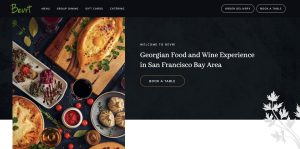Introduction
1. Captivating and Branded Design
How should a restaurant website look like? A website for a restaurant really needs to have a design that is both aesthetically pleasing and branded. It ought to encapsulate the spirit of your business and leave an indelible imprint on guests that come to your establishment. In order to strengthen the brand identification of your restaurant, include the restaurant’s logo, colour scheme, and font throughout the entirety of the restaurant’s website.
2. Clear and Intuitive Navigation
You should make sure that the menu structure on your website is well-organized and simple to browse. Make sure that the elements on your navigation menu have labels that adequately describe what they do, such as “Menu,” “Reservations,” “About Us,” and “Contact.” Users will be able to easily and quickly find the information they require as a result of this.
3. Eye-Catching Food Imagery
Displaying examples of the restaurant’s mouthwatering fare is among the most essential components of a website for the establishment. Include photographs of your delectable foods that are of a high quality and will tempt potential customers to dine at your establishment. Make sure that the photographs have been properly optimised for viewing on the web so that they will load quickly and appear well on any screen.
4. Mobile-Friendly Responsiveness
Because of the proliferation of mobile devices, it is essential to have a website that is optimised for mobile use. Your website should automatically adjust itself to look well on a variety of screen sizes and resolutions. Implement responsive design strategies to offer a consistent and engaging surfing experience for mobile users. How should a restaurant website look like?
5. Highlight Special Offers and Promotions
Make sure that your website prominently features information about your special specials, seasonal menus, and promotions. Build a section or banner that is solely devoted to attracting the attention of site visitors and encouraging them to take advantage of the special offers you have available. This helps generate sales and encourages customers to return again and again.

6. Online Reservation and Ordering System
Customers will appreciate the convenience of being able to place an online purchase or table reservation directly from your website. Install a reservation and ordering system that is both simple to use and very intelligent, and ensure that it is compatible with all of your business processes. This makes the booking process easier on the customer and increases their overall pleasure. How should a restaurant website look like?
7. Customer Reviews and Testimonials
Include on your website a section dedicated to showcasing favourable reviews and testimonials from previous customers. This helps potential clients develop a sense of confidence and credibility in your brand. You might want to think about integrating services like Yelp or TripAdvisor so that you can display genuine reviews and ratings.
8. Contact Information and Location
On your website, make sure that your contact information, such as your phone number, email address, and physical location, is easy to find. If you want to provide clear directions to your business, you might want to think about incorporating a Google Maps widget. Because of the information provided here, prospective clients will have an easier time locating and contacting you. For dynamic cardiologist website design see here.
9. Social Media Integration
Installing buttons or links for your various social media profiles on your website will allow you to connect the two. This makes it simple for customers to follow your restaurant on social media networks such as Facebook, Instagram, and Twitter and to interact with it there. Make sure that your social media platforms are kept up to date on a consistent basis so that your customers are aware of any new menu items, events, or specials.
10. SEO Optimization
It is essential to optimise your content by making use of the correct HTML title tags in order to increase the likelihood that search engines like Google will have no trouble indexing your website. You should make use of h1> tags for the primary heading of your page, h2> tags for the headings of the sections, and h3> tags for the headings of the subsections. Your website will have a greater chance of being visible in search results if it has a structure that assists search engines in comprehending the hierarchy of its material. https://diversewebsitedesign.com.au/
Conclusion
A website for a restaurant that has been thoughtfully created is a potent instrument for luring new clients and propelling business expansion. You will be able to develop a website that is not only visually beautiful but also user-friendly and helpful to search engines by adhering to the best practises described above, including the efficient use of HTML title tags. This website will provide the finest possible representation of your restaurant. It is important to remember to optimise your website for mobile devices, feature mouthwatering food imagery, highlight special offers and promotions, provide an easy-to-use reservation and ordering system, display customer reviews and testimonials, ensure that contact information and location details are clear, integrate social media, and optimise your website for search engines by using HTML title tags correctly.





